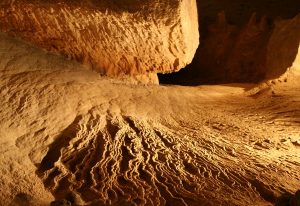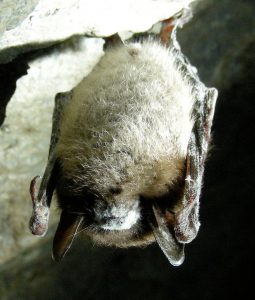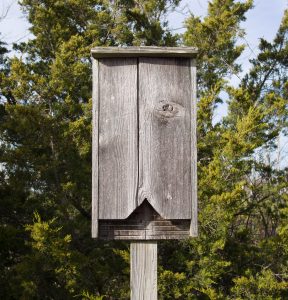In the month of October, thoughts turn to sunless places and creatures of mythic darkness. So many of these creatures--zombies, werewolves, and mummies--live only in our imaginations, coming to the forefront of our thoughts in the bright light of the October full moon. But one symbol of the eerie month is quite real and exists alongside us, awakening as humans withdraw into their houses for the night--the bats! Bats are widespread in Virginia, and the caverns in our mountainsides provide excellent homes for them. Join us as we explore the world of caves and bats in Virginia.
Darkest Delves: The Caverns Near You
There are many impressive caverns in Virginia, and one of the most expansive is Luray Caverns. It is located in the Blue Ridge Mountains in the northwest of the state and was originally discovered in 1878. The cavern is noted for its impressive stalactites and stalagmites, which are formed by water carrying dissolved limestone down through the cave's roof. A major attraction at Luray is its Great Stalacpipe Organ, the largest musical instrument in the world. Over 60 years old, this massive lithophone creates music by tapping on stalactites of different sizes throughout the cavern. There are enough stalactites of various sizes to create an entire musical scale. In spite of all these natural wonders, one thing Luray does not have is a large bat colony of its own.
Bats can be found in considerable numbers in some of Virginia’s other caverns, such as Endless Caverns. Endless Caverns is a 5.5-mile-long cave system in New Market, Virginia. Similar to Luray, it offers guided tours, but, unlike Luray, bat colonies are visible from the tour route. The bats that are most common in Endless Caverns are little brown bats. This cavern was first discovered in 1879 by two boys hunting rabbits, and access has slowly expanded over the years as the cave continues to be explored. This cavern is considered a “living cave,” meaning it is still being hollowed out from the rocks by the steady drips of water. Who knows how expansive it may be and how many bats may live inside in 100 years?
Another cavern system in Virginia that features bat colonies is the Caverns at Natural Bridge. First opened to the public in 1977, this cave is of ecological importance because two species exist only in this cave; the Natural Bridge Cave Beetle and Natural Bridge Isopod. Creatures that live in caves that do not fly or travel outside like bats can become so adapted to life inside a particular cave that they can become a unique species, and caves are an important part of Earth’s biodiversity. The Caverns at Natural Bridge are infamous in Virginia lore because early explorers heard strange sounds deep within, leading some to believe the caves were haunted. Though ghostly encounters have become less frequent since the caves were opened to the public, bats can be seen often in this cave.
These and more impressive caves can be found along Virginia’s Cave and Karst Trail. Virginia’s caves are located mainly in the Ridge and Valley Province in the Appalachians, where limestone and shale have become eroded by water. Karst landscapes become defined by cracks and holes in the bedrock as water flows deep into the earth, forming underground streams. Karst is valuable for humans because it can provide a source of clean drinking water from its aquifers. The caverns that form in karst are also valuable habitat for many species of bats, and some species live only inside the limestone caves of karst.
Bats: The Night Fliers
One bat exclusive to limestone caves is Virginia’s state bat, the Virginia big-eared bat. The big eared bat is medium sized for a bat (between 3.5 to 4.5 inches in length) and is most noted for its large, diagonally slanted ears. Bats tend to live much longer than other small mammals, and the big-eared bat can live up to 16 years. Because they can only live in limestone caves, the amount of habitat for big-eared bats is limited, and they suffered population declines in earlier decades of cave exploration. They eat only insects, with moths making up most of their diet. Both of Virginia’s big-eared bat caves are located in Tazewell County, and there has been a slow population increase now that the caves are better protected. Unless you live in a county near their caves, you are unlikely to see a big-eared bat in person.
Some of Virginia’s other bat species are considerably more widespread than the big-eared bat, and can be found in holes in trees, rocks, and even houses. The smallest of Virginia’s bats is the little brown bat. These bats do not need a cave to roost in; they can use most dark places they can fit their bodies into, even a wood pile. When they become active at night, little brown bats must find many insects to satisfy their hunger; they must eat half their body weight each night to remain healthy. This bat can be distinguished by its relatively small nose and short wingspan. The range of the little brown bat includes the entire state of Virginia, and you may find them active in Fredericksburg at dusk during spring and summer.
The big brown bat is the largest and most common of Virginia’s bats. Its extensive range includes all the Lower 48 states. Big brown bats have a 16-inch wingspan, short ears, and are about 5 inches long. They roosted in holes in trees before European settlers reached America, but often choose buildings, the undersides of bridges, and bat boxes as their roosts now. Big brown bats eat a wide variety of insects, including pests such as cucumber beetles and stink bugs. They typically live about 6.5 years, although they can live up to 19 years. Big brown bats can stay active for longer in the year than other bat species because of their larger body mass, only hibernating in November. During the summer, you may find colonies of big brown bats in structures such as old church steeples, barns, or sheds.
Bat Boxes: Preserving the Bat Population
Unfortunately, all bats on the North American continent face a new, deadly threat. Since 2006, white-nose syndrome, a fungal disease, has killed bats in large numbers. It appears as a powdery white color on the nose and arms of affected bats and causes them to behave in unusual ways, such as flying outside during the day and waking up when they should be hibernating. The fungus irritates the bat by invading its skin tissues and prevents the bat from sleeping, resulting in the bat starving to death after exhausting its fat reserves. Both of Virginia’s common bat species, the little brown bat and the big brown bat, have suffered population losses as a result of this disease. Numbers of the little brown bat have declined by 90 percent since the discovery of white-nose syndrome. So far, the only Virginia bat that is resistant to white-nose is the rare Virginia big-eared bat, which protects itself with a yeast that grows on its body that prevents the fungus from doing damage.
You can help bats recover from this disease by putting up a bat box. Depending on your budget and what materials you have available, there are several different ways you can design housing for bats, although the best design should be a minimum of 20 inches tall and 14 inches wide. Your bat box should have a decent amount of sun exposure, be within a quarter mile of a stream or pond, and be as dry as possible. If you don’t want to build your own bat house, you can search eBay for pre-built bat boxes or buy a kit with the materials you’ll need to build one. One last tip; if you have owls in the area, put your bat box as far from the owl roost as possible. Owls are a predator of bats, so if you want to help support a colony in bat housing, make their home a safe place! With ingenuity, you can make the world a better place for bats and help restore their population.
A list of books about interesting caves and bats!








